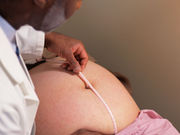Previously observed link could be due to maternal characteristics or socioeconomic, genetic factors
TUESDAY, July 26, 2016 (HealthDay News) — Inducing labor won’t raise a pregnant woman’s risk of having a child with autism, according to a study published online July 25 in JAMA Pediatrics.
Brian Bateman, M.D., an anesthesiologist at Massachusetts General Hospital and Brigham and Women’s Hospital in Boston, and a team led by the Harvard T.H. Chan School of Public Health used a database on all live births in Sweden from 1992 through 2005. The researchers analyzed child outcomes for more than one million births through 2013, to identify any children diagnosed with a neuropsychiatric condition. They also identified all the children’s brothers, sisters, and cousins on their mother’s side of the family. The health of the children’s mothers was also taken into account.
Labor induction was performed in 11 percent of the deliveries. These births often involved complications, such as diabetes, high blood pressure, and preeclampsia. The researchers noted that 23 percent of the induced pregnancies were late deliveries (after 40 weeks of pregnancy). Nearly 2 percent of the infants in the study were later diagnosed with autism during the follow-up period. When just looking at unrelated children, the researchers did find a link between induced labor and a greater risk for an autism spectrum disorder. This association disappeared, however, once they also considered the women’s other children who were not born from an induced labor.
“When we used close relatives, such as siblings or cousins, as the comparison group, we found no association between labor induction and autism risk,” study author Anna Sara Oberg, Ph.D., a research fellow in the department of epidemiology at the Harvard Chan School. Explaining further, she said in a university news release that “many of the factors that could lead to both induction of labor and autism are completely or partially shared by siblings — such as maternal characteristics or socioeconomic or genetic factors.” Therefore, Oberg said, “previously observed associations could have been due to some of these familial factors, not the result of induction.”
Copyright © 2016 HealthDay. All rights reserved.








